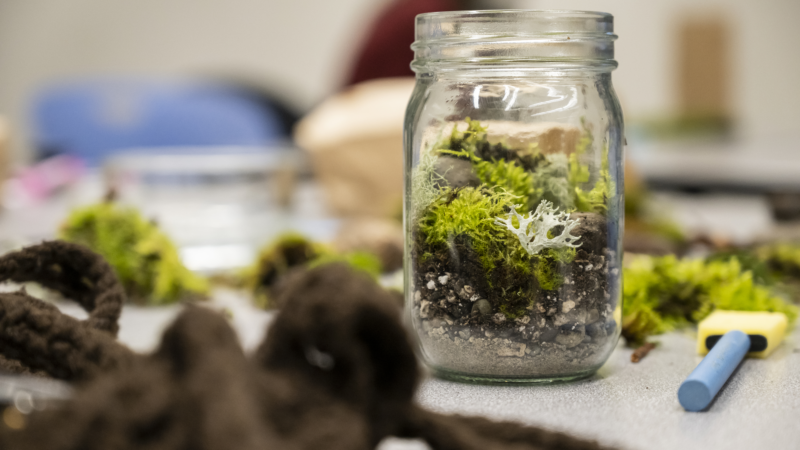‘Moss Appreciation Week’: a lot of celebration for a very little plant
When it comes to plants, there are some that really command attention, like majestic redwoods or elegant roses. And then…. there’s moss, which doesn’t usually get a lot of love, or even get noticed at all.
But in Portland, Oregon, students at Lewis & Clark College have been trying to change that with their annual Moss Appreciation Week: a five-day festival held every February to celebrate and get up-close with the humble green carpet students walk past every day.
Moss walks, talks, and even valentines
The event got its start a few years back, when a Lewis & Clark student spent the summer working at Portland State University’s Herbarium and fell in love with mosses, according to Parvaneh Abbaspour, Lewis & Clark’s science librarian. Abbaspour helped the student set up an exhibit at the library and has been working with the school’s Natural History Club to run Moss Appreciation Week since then. The festival is now in its seventh year.
”Moss is something that’s underappreciated,” says Madeline Jones, one of the student organizers of this year’s event. “So we’re taking some time to appreciate the moss that makes our campus beautiful.”
Moss Appreciation Week is packed with events both scientific and downright silly. Moss walks, moss talks, moss movies, crafting moss-themed Valentines (it’s hard to resist “I Lichen You A Lot” puns), which students look forward to every year. Some students dress up as moss.

(Suhail Akram | Lewis & Clark)
Others pass out moss-covered cupcakes (covered with crumbles of matcha cake to look like moss). There are moss terrarium building workshops, and a “gastropod derby,” where snails and slugs (for whom moss is a nice moist microclimate) “race” down PVC chutes toward a yeast-soaked clump of moss at the finish line.
There’s also a moss petting zoo – a table with a few dozen moss samples set up in the library, showing the full diversity of mossy forms.

(Nina Johnson | Lewis & Clark)
“It kind of makes me think of like, if you had the opportunity to pet a muppet, this is what you would encounter,” laughs Robin Anderson, the library worker tasked with misting the samples every few hours to keep them moist.
“I don’t think there is a moss with a bad texture,” says student Saph Leeper. “ Like this could be like a rug. And honestly, I would buy a rug like this.”
‘It takes some work to lean in and look’
Watching a bunch of students lavish attention on moss for a whole week begs the question: why?
According to Jenna Ekwealor, a researcher who runs San Francisco State University’s moss lab, and spoke at last year’s Moss Appreciation Week, it’s well deserved. She says moss is a really special plant that more people should know more about. Although Ekwealor argues that mosses, like all organisms, should be appreciated for themselves, she is happy to run through the greatest hits of what makes the plants particularly compelling.
“They’re tiny plants, but they’re different from most plants we see,” explains Ekwealor. “They don’t have any roots… so they take in all of their water straight through their leaves.”

Ekwealor says because mosses don’t really need soil, and because they can survive long droughts, they grow where a lot of other plants can’t. Although people often think of mosses as the plants of rainy places (like the Pacific Northwest), they’re actually found everywhere – from the highest mountaintops to the driest valleys. And they play an important role in ecosystems.
“They prevent erosion and runoff,” says Ekwealor. “They act like sponges out there and they can purify or clean air and water.”
She also says mosses can change our perspective. For example, their ability to go dormant and regrow makes her think about resilience. And the fact that mosses can reproduce clonally, and form a unit with other lichens and organisms, makes her think philosophically about what it means to be an individual.
Plus, they’re ancient. Mosses have been around for 400 million years, according to Ekwealor. And she says a moss-like ancestor helped create the oxygen levels that made human life possible. On top of all that, there’s still a lot about them we don’t know.
So, with such a fascinating resume… why don’t more people care about mosses?
“Part of the reason that they have been sort of neglected or underappreciated over time is simply because they’re small,” theorizes Ekwealor. “And it takes some work to lean in and look at this tiny thing.”
Focusing on the little things
At Moss Appreciation Week, an entire campus is leaning in to look at the world of moss. “It’s a nice little escape this week,” laughs organizer Kenji Yamamoto. “Just to focus on the little things, and slow down to the pace of moss, if you will.”

Gathering mosses for the terrarium-building workshop, sophomore Deenie Bulyalert acknowledges that the event is, indeed, goofy. But it’s also more than that.
“ I think other people can view it as like, ‘oh, it’s so silly to kneel down and look at plants. They exist every day in our life.’ But I think it is so profound, because it’s little things that we don’t even notice every single day.”
Ekwealor notes that taking stock of the little things doesn’t get rid of life’s challenges. “But it does help me put things into balance, and realize that there’s still a lot here on this earth, a lot of life, a lot of beauty, that is enduring all of the hardships with us.”
You don’t need Moss Appreciation Week to find that beauty – you can step outside any week, almost anywhere, and find it.
Transcript:
MICHEL MARTIN, HOST:
When it comes to plants, some really command our attention. Redwoods – so majestic. Roses – elegant. And then there’s moss – you know, the green stuff, looks like carpet. It doesn’t usually get a lot of love. But in Portland, Oregon, some college students have been trying to change that. Deena Prichep takes us to the seventh annual Moss Appreciation Week.
DEENA PRICHEP: At the library at Lewis & Clark College, kids are reading, playing chess and also checking out the moss petting zoo. It’s a couple dozen chunks of moss that get misted every few hours.
(SOUNDBITE OF SPRAY BOTTLE SQUIRTING)
PRICHEP: People stop by and gently stroke them. Here’s Robin Anderson, Saph Leeper and Alex Nash.
ROBIN ANDERSON: It kind of makes me think of, like, if you had the opportunity to pet a Muppet, this is what you would encounter.
SAPH LEEPER: I don’t think there is a moss with a bad texture.
UNIDENTIFIED PERSON: Yeah.
LEEPER: And that’s my hot take.
ALEX NASH: I like how it just sort of looks like a bunch of carpet samples.
PRICHEP: Outside, you can walk a trail through the campus woods, where speakers on the moss-covered trees play the word for moss in various languages, and then get a cup of hot cider and moss-covered snacks. Well, not actual moss, says Soff Olmedo, who did the baking last night.
SOFF OLMEDO: Cupcakes, with matcha cake on top that make them look like moss, stuck together with some chocolate frosting.
PRICHEP: There are moss walks, moss talks, moss, movies, moss valentines. There are even students dressed as moss, sort of draped over logs.
Do you want to tell me what it’s like to be moss?
UNIDENTIFIED STUDENT: Green. I’m feeling very green right now.
PRICHEP: It is silly and scientific and makes you wonder, why all this fuss over moss? This event was started by a student at Lewis & Clark here in Portland, who spent the summer working with moss and got kind of fascinated. And then the school’s Natural History Club picked it up from there.
Professor Jenna Ekwealor runs San Francisco State University’s moss lab and spoke at last year’s Moss Appreciation Week. She’s happy to see moss getting some love.
JENNA EKWEALOR: They’re tiny plants, but they’re different from most plants we see. They don’t have any roots, so they take in all of their water straight through their leaves.
PRICHEP: Ekwealor says because mosses don’t really need soil and because they can survive long droughts, they can grow where a lot of other plants can’t.
EKWEALOR: They are actually in every habitat, from the highest mountaintops to the driest valleys.
PRICHEP: And they play an important role.
EKWEALOR: They prevent erosion and runoff. They act like sponges out there, and they can purify or clean air and water.
PRICHEP: Mosses have been around for 400 million years, according to Ekwealor. She says a mosslike ancestor helped create the oxygen levels that made human life possible.
EKWEALOR: Part of the reason that they have been sort of neglected or underappreciated over time is simply because they’re small, and it takes some work to lean in and look at this tiny thing.
PRICHEP: And when you take a close look, it can change your perspective. At Moss Appreciation Week, sophomore Deenie Bulyalert says it might seem silly to kneel down and look at plants that are so common.
DEENIE BULYALERT: But I think it is so profound because it’s little things that we don’t even notice every single day.
PRICHEP: Lewis & Clark’s Moss Appreciation Week runs through Friday, but moss itself, of course, can be appreciated anytime. Just look around.
From Portland, Oregon, I’m Deena Prichep.
(SOUNDBITE OF KALOS’ “ALLEN WATER”)
Nigeria’s former President Muhammadu Buhari dies at 82
Nigeria's former president Muhammadu Buhari — who once ruled as a military dictator before returning decades later as an elected leader — has died at 82.
Los Angeles houses of worship plan for possible ICE Raids
Churches in Los Angeles put contingency plans in place after the Trump administration rescinds long-standing guidance advising immigration agents to avoid houses of worship.
‘Love Island USA’ might decenter whiteness — but the show still won’t face reality
The finale of Love Island USA airs Sunday night. Critic Aisha Harris says it's impossible to separate the season's racial and ethnic diversity from the show's mealy-mouthed handling of behind-the-scenes drama.
Folklife stars: Maya artist, Bolivian rappers, Dolly Parton’s guitar restorer
They all showed off their talents at this year's Smithsonian Folklife Festival. The theme: How youth keep cultural traditions alive.
Israeli strikes in Gaza kill at least 19, hospitals say, as ceasefire talks drag on
Israeli strikes in the Gaza Strip killed at least 19 people on Sunday, including six children at a water collection point, local health officials said.
‘Panicking’: Why recent college grads are struggling to find jobs
Recent college graduates are facing one of the most challenging job markets in years — with the exception of the pandemic period — even as the overall unemployment rate remains low.









